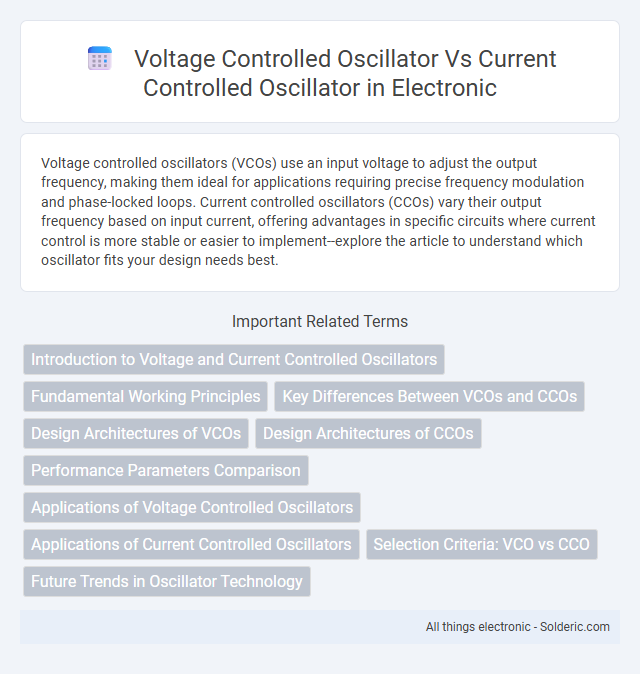Voltage controlled oscillators (VCOs) use an input voltage to adjust the output frequency, making them ideal for applications requiring precise frequency modulation and phase-locked loops. Current controlled oscillators (CCOs) vary their output frequency based on input current, offering advantages in specific circuits where current control is more stable or easier to implement--explore the article to understand which oscillator fits your design needs best.
Comparison Table
| Feature | Voltage Controlled Oscillator (VCO) | Current Controlled Oscillator (CCO) |
|---|---|---|
| Control Parameter | Voltage | Current |
| Frequency Range | Wide and easily adjustable | Narrower, depends on current source precision |
| Frequency Stability | Moderate; affected by voltage noise | Higher; less susceptible to voltage noise |
| Linearity | Moderate linearity with control voltage | Better linearity with control current |
| Power Consumption | Typically lower power | Generally higher due to constant current |
| Applications | PLL circuits, frequency synthesis, communication systems | Frequency synthesis, clock generation, precision timing |
| Implementation Complexity | Simpler circuit design | Requires precise current source, more complex |
Introduction to Voltage and Current Controlled Oscillators
Voltage Controlled Oscillators (VCOs) generate oscillation frequencies directly proportional to an input control voltage, commonly used in phase-locked loops and frequency synthesis. Current Controlled Oscillators (CCOs) vary their output frequency based on an input control current, offering advantages in linearity and noise performance for integrated circuit applications. Both oscillator types are essential in communication systems but differ in their control mechanisms and design trade-offs.
Fundamental Working Principles
A Voltage Controlled Oscillator (VCO) generates an output frequency that varies according to the input control voltage, leveraging varactor diodes or capacitive elements to alter the oscillation frequency. In contrast, a Current Controlled Oscillator (CCO) modulates its frequency based on the applied input current, typically adjusting the bias current of an active device to change the oscillation frequency. Both oscillators are fundamental in frequency synthesis but differ primarily in their control mechanisms--voltage versus current.
Key Differences Between VCOs and CCOs
Voltage Controlled Oscillators (VCOs) adjust their output frequency based on an input voltage, while Current Controlled Oscillators (CCOs) vary frequency through an input current. VCOs offer higher linearity and are widely used in phase-locked loops and communication systems, whereas CCOs provide faster frequency tuning range and lower power consumption, making them suitable for integrated circuit applications. Your choice between VCOs and CCOs depends on the required frequency stability, tuning sensitivity, and power constraints of the electronic design.
Design Architectures of VCOs
Voltage controlled oscillators (VCOs) utilize architectures such as ring oscillators and LC oscillators, where the oscillation frequency is modulated by varying the control voltage applied to varactors or voltage-sensitive elements. Current controlled oscillators (CCOs) primarily rely on current steering or current-starved inverters to adjust the oscillation frequency through changes in control current, offering linear frequency tuning and improved noise immunity. The design of VCOs focuses on achieving low phase noise and wide tuning range, while CCOs emphasize simpler tuning mechanisms and better integration with current-mode circuits.
Design Architectures of CCOs
Current controlled oscillators (CCOs) feature design architectures that rely on variable current sources to control the oscillation frequency, offering fine-tuned frequency adjustability with relatively linear control characteristics. Common CCO designs include relaxation oscillators and LC tank oscillators, where transconductance stages convert current variations into frequency shifts, enhancing stability and phase noise performance. Your choice of CCO architecture impacts integration complexity, power consumption, and tuning range, making it critical to align design parameters with specific application requirements.
Performance Parameters Comparison
Voltage controlled oscillators (VCOs) offer superior frequency range and linearity compared to current controlled oscillators (CCOs), making them more suitable for high-frequency applications. VCOs typically exhibit lower phase noise and faster tuning speeds, which enhance their performance in communication systems and signal processing. Your choice depends on specific requirements, with CCOs providing simpler design and lower power consumption but at the cost of reduced frequency stability and tuning precision.
Applications of Voltage Controlled Oscillators
Voltage controlled oscillators (VCOs) are widely used in phase-locked loops (PLLs) for frequency synthesis in communication systems, enabling precise frequency tuning and modulation. They are essential components in RF signal generation, frequency modulation (FM) transmitters, and voltage-controlled filters in analog synthesizers. Current controlled oscillators (CCOs) offer similar functionality but are less common in high-frequency applications due to limited linearity and control precision compared to VCOs.
Applications of Current Controlled Oscillators
Current Controlled Oscillators (CCOs) are extensively used in frequency modulation, phase-locked loops (PLLs), and signal synthesis due to their precise frequency control through current variation. You will find CCOs advantageous in integrated circuit design and communication systems where compactness and power efficiency are critical. These oscillators excel in applications requiring linear frequency tuning and low phase noise.
Selection Criteria: VCO vs CCO
Selecting between a Voltage Controlled Oscillator (VCO) and a Current Controlled Oscillator (CCO) depends on key factors such as frequency stability, tuning range, and control signal type. VCOs are preferred for applications requiring wide frequency tuning and ease of integration with voltage-based control systems, offering faster response times and simpler interface circuits. CCOs provide finer frequency resolution and superior linearity in current-driven environments, making them ideal for analog signal processing and systems demanding precise current control.
Future Trends in Oscillator Technology
Future trends in oscillator technology emphasize the integration of Voltage Controlled Oscillators (VCOs) and Current Controlled Oscillators (ICOs) into highly miniaturized, low-power, and ultra-high-frequency applications for 5G and beyond. Advances in semiconductor materials and MEMS technology enable oscillators with enhanced frequency stability, lower phase noise, and wider tuning ranges, catering to your evolving communication and sensing needs. Research is also focusing on hybrid oscillator architectures that combine the fast tunability of VCOs with the precise control of ICOs to achieve optimal performance in IoT and wearable devices.
Voltage controlled oscillator vs Current controlled oscillator Infographic

 solderic.com
solderic.com